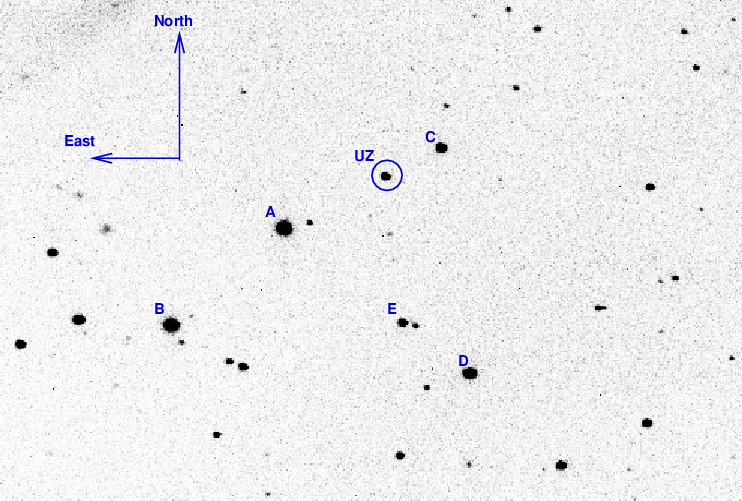
On the night of Aug 19/20, 2013, I observed UZ Boo and SN 2013ej in M74. Conditions were good -- no clouds, decent seeing. The nearly full moon was very bright, making the UZ Boo measurements particularly noisy.
The main setup was:
Notes from the night
I took a series of images of UZ Boo, using a 150-second exposure time, since UZ Boo has been faint recently. Tonight, the star was fading again, reaching mag V = 16.5 or so. If it doesn't rebrighten, I'll need to increase the exposurure time -- or maybe give up.

The zero-point offset graph shows clouds a slow, steady rise as UZ Boo slowly set.
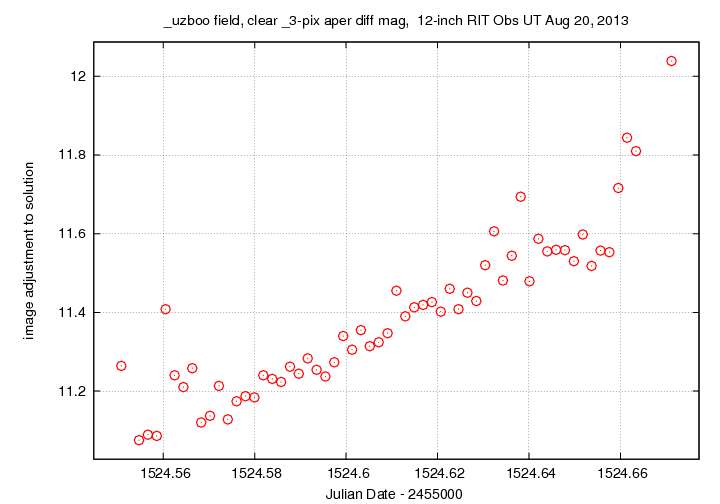
I measured UZ Boo and many other stars in the field. The bright stars "A", "B" and "D" were somewhat saturated, so I left them out of the ensemble solution. Instead of the star "A", I used the star "E" = UCAC4 561-055129 = AAVSO 000-BBV-649 to shift the instrumental magnitudes to the standard scale. Remember, the measurements are made without a filter , but I'll shift them to match the V-band scale: 000-BBV-649 has mag V = 14.267 according to the AAVSO chart 12447AMF.
Because the sky was so bright, I used a smaller aperture to measure the stars than usual: radius of 3 pixels (5.6 arcsec) instead of 4 pixels (7.4 arcsec).
Below are light curves for UZ Boo and several of the unsaturated stars in the field:
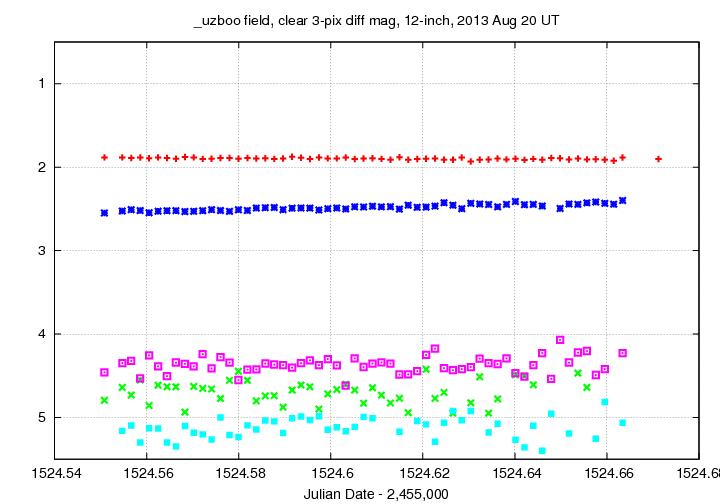
Here's a closeup of UZ Boo and stars of similar faintness. The noise is very large, probably swamping any variation in UZ Boo itself.
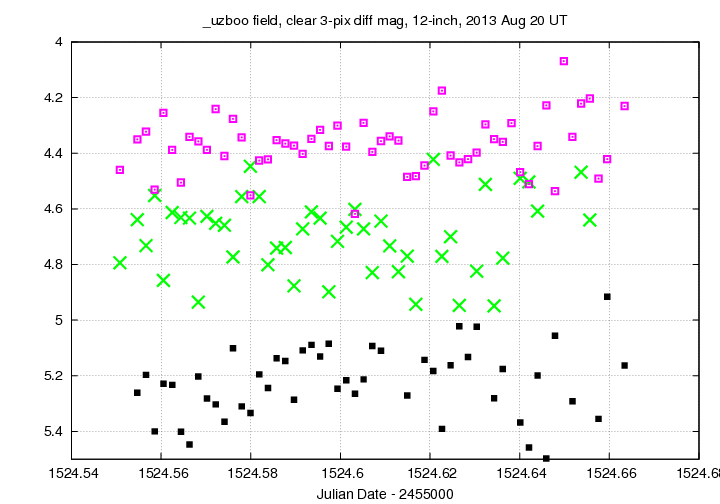
The variable star has entered a phase in its evolution in which it fades by about 2 mag, then rebrightens, then fades again, then rebrightens, etc. My measurements at the RIT Observatory catch UZ Boo at several places in this complicated evolution; tonight, it was fading again, reaching the faintest point I've seen.
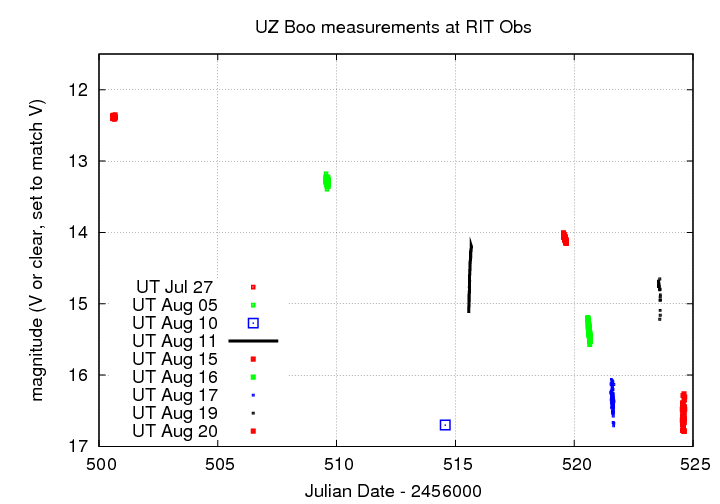
Below are the first few lines of the report I've sent to the AAVSO and VSNet.
# Measurements of UZ_Boo made at RIT Obs, Aug 20, 2013 UT, # in good but bright conditions, # by Michael Richmond, using 12-inch Meade and SBIG ST-8E CCD. # Exposures 120 seconds long, clear filter. # Tabulated times are midexposure (FITS header time - half exposure length) # and accurate only to +/- 1 second (??). # 'mag' is a differential magnitude based on ensemble photometry # using a circular aperture of radius 5.6 arcseconds. # which has been shifted so UCAC4 561-055129 has mag=14.267 # which is its V-band magnitude according to AAVSO. # # UT_day JD HJD mag uncert Aug20.05083 2456524.55083 2456524.54870 16.633 0.127 Aug20.05470 2456524.55470 2456524.55257 16.478 0.113 Aug20.05664 2456524.55664 2456524.55451 16.571 0.124
SN 2013ej is a Type II supernova in the relatively nearby galaxy M74. It was discovered by the KAIT group some time (a week?) before maximum light. Here's a chart showing the galaxy, the SN, and some reference stars:
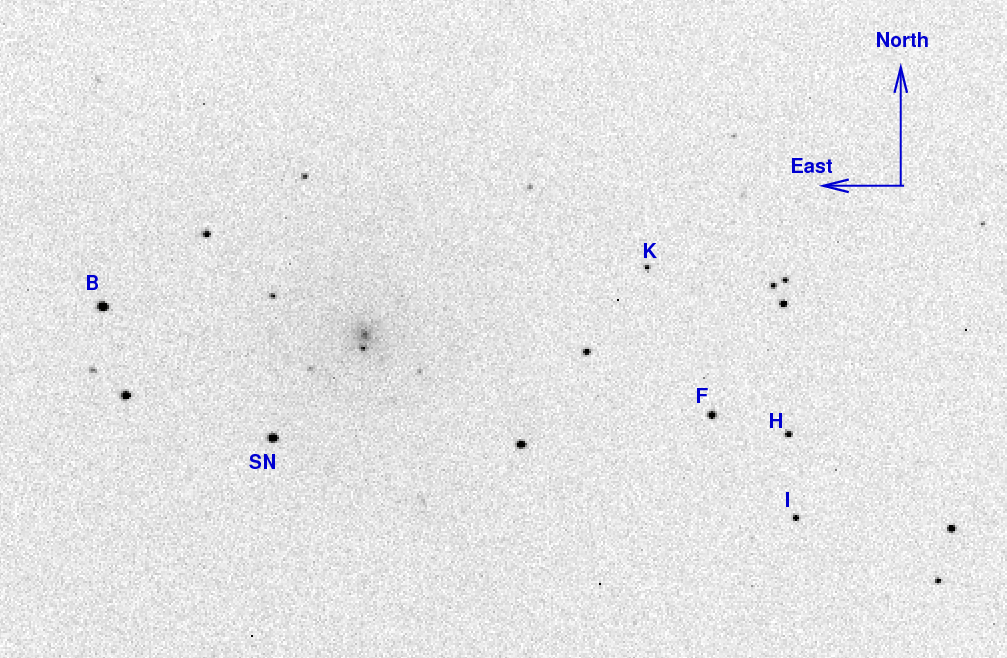
The reference stars marked above have magnitudes in AAVSO chart 12459CA, as follows:
letter B sigB V sigV R sigR I sigI B 13.012 0.019 12.510 0.019 12.154 0.019 11.834 0.019 F 13.848 0.026 13.065 0.022 12.622 0.025 12.152 0.027 H 14.338 0.029 13.692 0.024 13.329 0.029 12.964 0.030 I 14.832 0.027 13.912 0.023 13.416 0.026 12.939 0.030 K 15.192 0.034 14.613 0.027 14.275 0.034 13.915 0.036
I took 30-second unguided images -- the sky was so bright that I couldn't hold the guide star reliably. After discarding the bad images, I was left with 9, 9, 10, and 9 images in B, V, R, and I, respectively.
Using aperture photometry with a radius of 4 pixels (radius of 7.4 arcsec), I measured the instrumental magnitudes of a number of reference stars and the target. Following the procedures outlined by Kent Honeycutt's article on inhomogeneous ensemble photometry, I used all stars available in each image to define a reference frame, and measured each star against this frame. I used the AAVSO magnitudes, plus color terms to convert the ensemble instrumental magnitudes to the standard Johnson-Cousins BVRI scale.
The transformation from instrumental to Johnson-Cousins magnitude had a larger uncertainty in the B-band than usual; I checked and saw that star "I", the faintest of the B-band reference stars, was about 0.2 mag away from the other reference stars in zeropoint. I discarded it from the B-band solution.
Results from this morning are:
filter mag mag_uncert Julian Date SN B = 13.564 +/- 0.094 (ens 0.093 zp 0.010) 2456524.69754 SN V = 12.748 +/- 0.039 (ens 0.030 zp 0.025) 2456524.69252 SN R = 12.378 +/- 0.028 (ens 0.018 zp 0.021) 2456524.68682 SN I = 12.237 +/- 0.051 (ens 0.034 zp 0.039) 2456524.70408
The uncertainties here are roughly equally distributed between extracting the instrumental magnitudes and transforming the instrumental magnitudes to the standard scale.
Grab the text file below for all the RIT measurements of SN 2013ej. All these values have been recomputed with the new color terms of UT 2013 Aug 05.
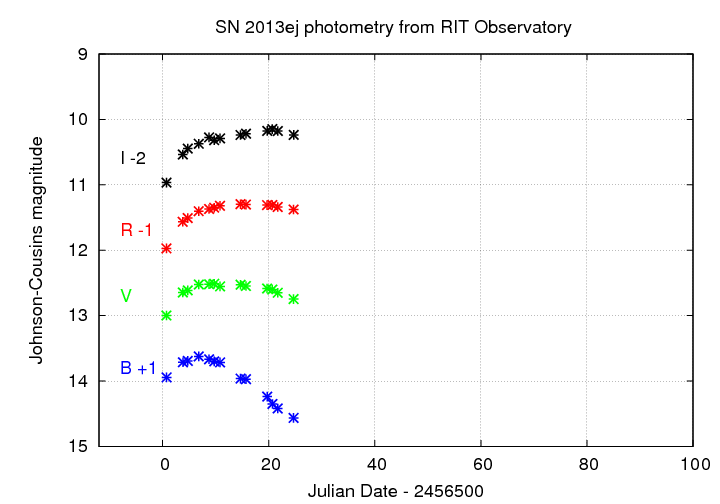
Last modified 08/20/2013 by MWR.